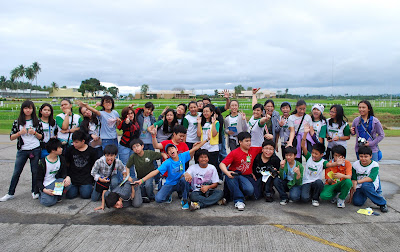This quarter, Sir Ryan introduced us to our last and final project: The Blogging Project.
 |
| The Blogging Project |
This project was a whole lot different project than the others. It wasn't our regular old projects where we research, make a power-point, make a handout and present it to the class kind of project. It wasn't making a oral defense either. So when Sir Ryan told us about the Blogging Project, it surprised us. We got to express ourselves through our posts here in blogger! You could see in our faces the excitement and curiosity building-up. Questions then formed in our minds like “Who among our members in the group is going to make our blog?” and “What's going to be the name of our blog?” and other questions similar to those. The Blogging Project is where we would get to express ourselves and feelings about our field trip, projects, and experiences through our posts in Blogger!
We admit, we had a hard time making our blog. We didn't know how to make one and who's going to make it. We then decided to go online so we could chat or 'IM' each other and Alex was able to make our blog. We thought of our name, we were desperate to find a good name for our blog so we kept thinking and thinking until we came up of “The Science Adventurers!”. Now, what's our URL going to be? We had a fun time mixing the first two to four letters of our name and came up of: migadikhalexclar.blogspot.com. We were ready and excited to share our adventurers in and out of school with you!
Now the name of our blog was all set, we encountered our first problem: Only Alex can access the blog even though she gave us the password she used for the blog. We had to send our compositions to her so she would be able to post them which was probably difficult to her because she was the only one doing it. It turned out that we needed the password for Alex's email which we used to make the blog to access the blog. We solved this problem when Alex gave Clarisse the correct password for our blog so Clarisse can help too. When Alex was absent for a week or so, luckily, Clarisse was able to access the blog or else they would rely again on Alex who was sick.
Now, if we were given a chance to do this CEO all over again, would we still do it? We would be honored to do this project once again only if it's Sir Ryan who would be still handling it and if we have more adventurers like field trips with him, but sadly, it's our last year in TLT. We would do this project once again because we don't usually have these kinds of projects in Science Class. We also learn how to express ourselves and making posts for you to read! It also develops our team-work with each other. We think this project can be further improve by not giving deadlines before exams and tests because it hassles us. This CEO was perfectly handled by Sir Ryan... except for the part about the deadlines being on the night before exams problem.
We learned so much important things in this awesome and fun- filled project we don't know what would be the most important. We learned that we all need to work together in order to accomplish the tasks. We learned that we shouldn't be lazy and not to cram about our posts because it will effect the outcome of our post meaning grammatical errors and stuff like that. We learned to have fun with our batch mates and We realized that we should treasure our environment given to us by our God. We should preserve and conserve them.We also realized that we might not have a project like this again because we will be leaving TLT and Sir Ryan, the one who introduced us to this wonderful project who will be staying behind, is unique in his own special way and we are grateful that God gave us a science teacher like him.
So Sir Ryan, we salute you and we will miss you when we leave.
'Till the next time, Urban Guru!
 |
| Our wonderful journey stays in our hearts. |
We had fun sharing our experiences with you, readers!
So long, farewell to you my friends
Good bye for now until we meet again.
Signing off for the last time,
Miguel, Adi, Khael, Alex, and Clarisse
The Science Adventurers
Honored to say GOODBYE.
Honored to say GOODBYE.











